"The Apocalypse, or Book of Revelation, is not only the last Book of the New Testament, but its most difficult, puzzling, and terrifying. It provided challenges to medieval illustrators and was the source for a number of popular images, such as Christ in Majesty, the Adoration of the Lamb, and the Madonna of the Apocalypse and contributed to the widespread use of the Evangelists' symbols." [source]
"The term "Beatus" identifies a particular medieval manuscript, generally of Spanish origin, that contains a collection of textual comments on the apocalypse of Saint John. The aim of the author, Beato of Liébana, was that of indoctrinating and educating the clergy, although, in some cases the manuscript was also used for certain rites and rituals.
The first version of the commentary was successively edited by the very hand of Beatus, as well as by later authors, each of whom contributed in creating different versions. There are 27 illuminated manuscripts that have been identified as having these characteristics and are, therefore, named "Beatus of Liébana" and are conserved in various libraries around the world." [source]
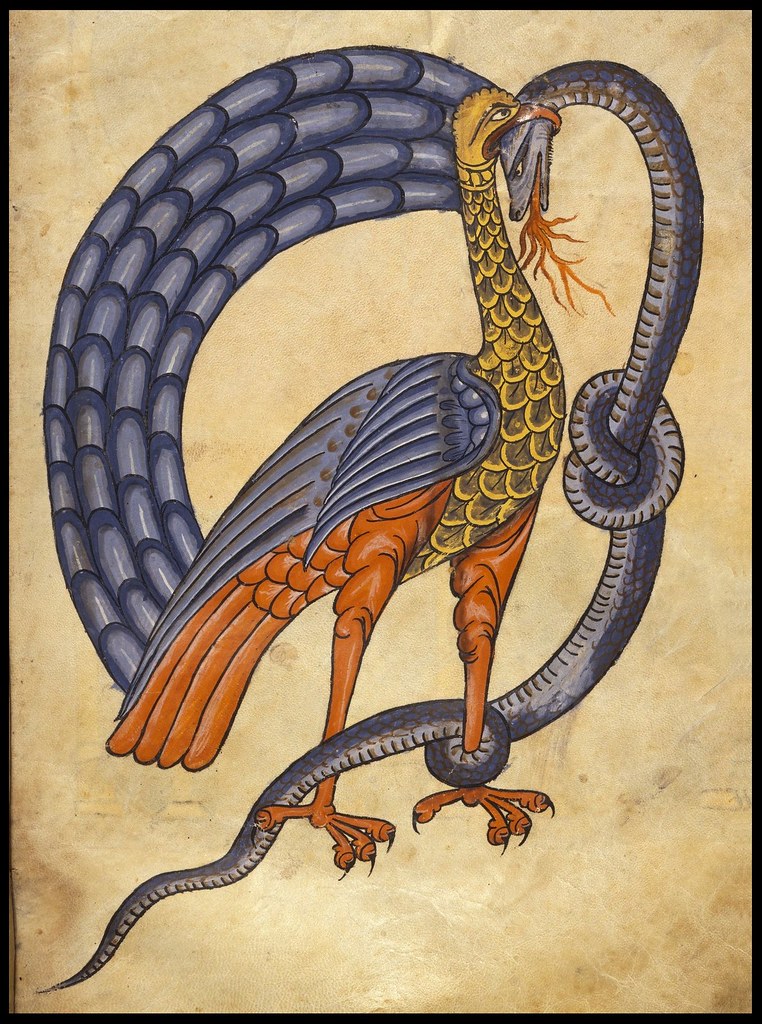
Bird (symbol of Christ) killing serpent (symbol of satan)
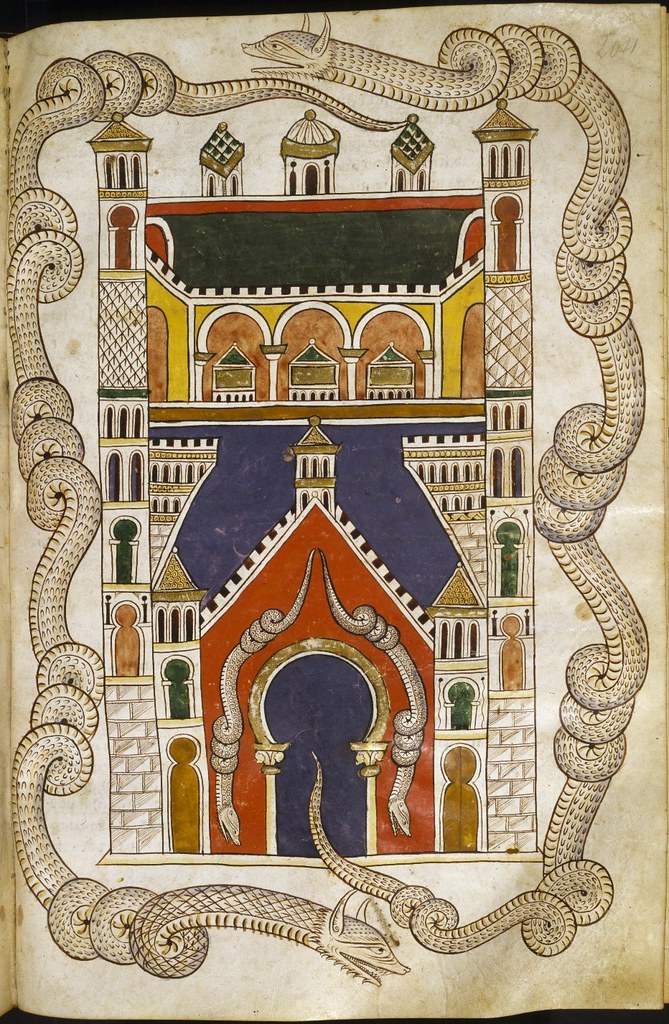
City of Babylon Surrounded by Serpents
This miniature of Babylon functioned as a frontispiece to the Book of Daniel. It was from Babylon that Nebuchadnezzar came and besieged Jerusalem. The entire city of Babylon is surrounded by two enormous serpents whose heads and tails fall on the central axis. Two more serpents flank the large doorway at bottom.
Above the door an arcade houses the silver coffins of the three Jews who were saved from the burning furnace: Hananiah, Mishael, and Azariah, worshiped as saints in Spain). An inscription below relates how Nebuchadnezzar took vessels from the temple of Jerusalem and how the wrath of God inflicted dragons, ostriches, and seductively singing owls and sirens on the city. Such accounts may have been inspired by the protective reliefs of dragons on Babylon's famous Ishtar Gate.
MS M.429 (fol. 147)
BOOK OF DANIEL
Although it was once thought that the author was Daniel, a Jewish exile in Babylon in the sixth century B.C., most scholars agree the book was written between 168 and 165 B.C. in support of Jews persecuted by the Seleucid emperor, Antiochus IV Epiphanes. The book was used as a pattern for later Jewish and Christian apocalypses, including the present Apocalypse of John, which also told of the fall of Babylon and the coming of Christ and his church. The Daniel cycle was added to Beatus manuscripts about 945, the same time that Maius introduced the prefatory cycle. The Daniel cycle, however, was not invented for this manuscript but derives from earlier illustrated Bibles.

Destruction of Babylon: the splendid city of Babylon — engulfed in flames — is a symbol of Satan and of all evil.
"And I saw another angel descending from heaven, saying: "Fallen, fallen is Babylon the great. And she has become the habitation of demons, and the keepsake of every unclean spirit, and the possession of every unclean and hateful flying thing." For this reason her afflictions shall arrive in one day: death and grief and famine. And she shall be burned with fire. And the kings of the earth, who have fornicated with her and lived in luxury, shall weep and mourn for themselves over her, when they see the smoke of her conflagration, standing far away, out of fear of her torments, saying: "Woe! Woe! to Babylon, that great and strong city. For in one hour, your judgement has arrived." And the businessmen of the earth shall weep and mourn over her, because no one will buy their merchandise anymore." [Revelations 18:1–11]

Top: Satan freed (Revelation 20:7) -- Horned seven-headed Beast (Antichrist) from Sea flanked by two groups of men representing nations
Middle: Satan, Siege of Holy City (Revelation 20:9) -- Men in upper part of gate of Holy City flanked by Antichrist crowned, holding book, and groups of men armed with swords and shield, representing Gog and Magog
Below, three groups of men seek refuge in the mountains
Satan's Last Attack: Gog and Magog
"And when the thousand years will have been completed, Satan shall be released from his prison, and he shall go out and seduce the nations which are upon the four quarters of the earth, Gog and Magog. And he shall gather them together for battle, those whose number is like the sand of the sea. And they climbed across the breadth of the earth, and they encompassed the camp of the saints and the beloved city." [Revelations 20:7–9]
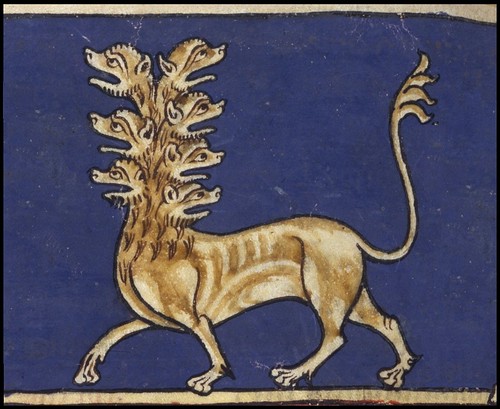
The Antichrist (detail)

This double-page world map is one of the manuscript's most intriguing illustrations. It is not called for by the Apocalypse text itself but is alluded to by Beatus, who writes about the various regions the twelve apostles were to evangelize (Peter, for example, went to Rome, Andrew to Acaya, Thomas to India, James to Spain, and John to Asia). The two vertical green areas on either side of the gutter* represent the Mediterranean Sea (the yellow rectangles are islands, such as Crete and Corsica). Europe is at the bottom left. In Spain, only Andalusia (Betica), Asturias, and Saragossa (Cesaraugusta) are listed. Africa is at the bottom right page, while Asia fills the top half of both pages. Below Adam and Eve in paradise are Jerusalem and Mt. Sinai.
*Ed. allow some poetic license here: this description pertains to a near-identical map from another version of the manuscript and maybe technical constraints prevent us seeing the scene in full]
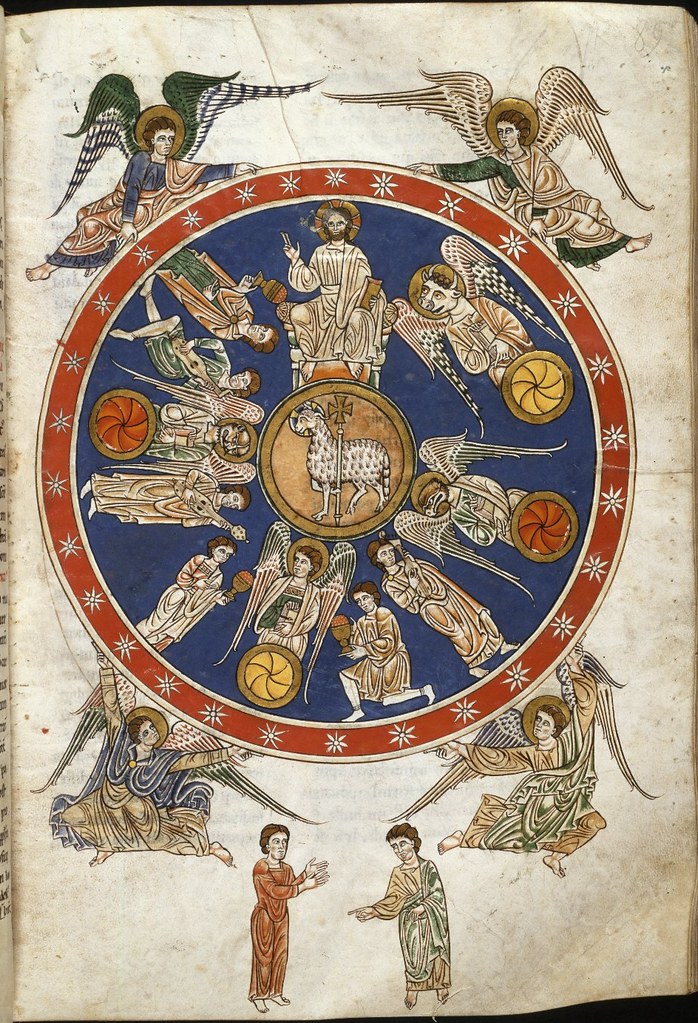
Lamb with cross
Vision Of The Lamb And The Four Living Creatures
Vision Of The Lamb And The Four Living Creatures
"And in the middle of the throne, and all around the throne, there were four living creatures. The first resembled a lion, the second an ox, the third had a face like a man, and the fourth resembled a flying eagle. And while those living creatures were giving glory and honor and blessings to the One sitting upon the throne, the twenty-four elders fell prostrate and adored him. And in the right hand of the One sitting on the throne, I saw a book, written inside and out, sealed with seven seals. And in the midst a Lamb was standing, as if it were slain. And when the lamb received and opened the book the four living creatures and elders fell down before the Lamb, each having stringed instruments, as well as golden bowls full of fragrances, which are the prayers of the saints. And they were singing a new canticle, saying: "O Lord, you are worthy to receive the book and to open its seals, because you were slain and have redeemed us for God, by your blood." "[Revelations 4:6–5:14]
At the end of the second century the four living creatures were connected with the evangelists, becoming their symbols (the man represents Matthew; the lion, Mark; the calf, Luke; the eagle, John). The creatures and fiery disks under them derive from Ezekiel's vision of the cherubim. The vision is enclosed by a starry border supported by four angels; and below John converses with an angel.
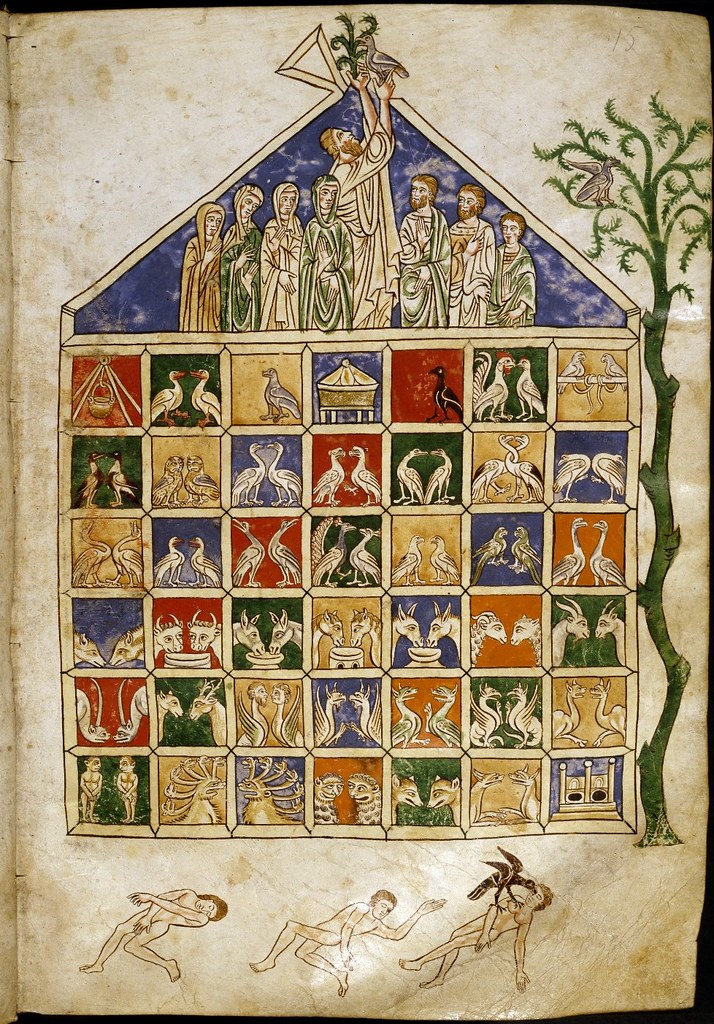
Noah's Ark
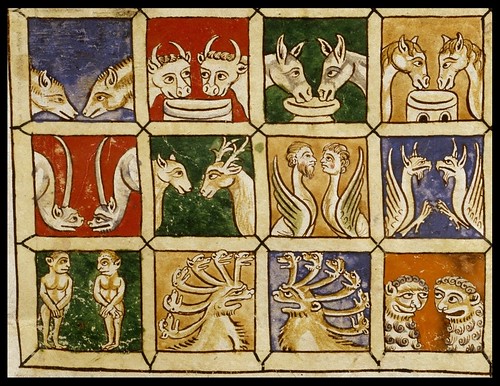
Noah's Ark (detail)
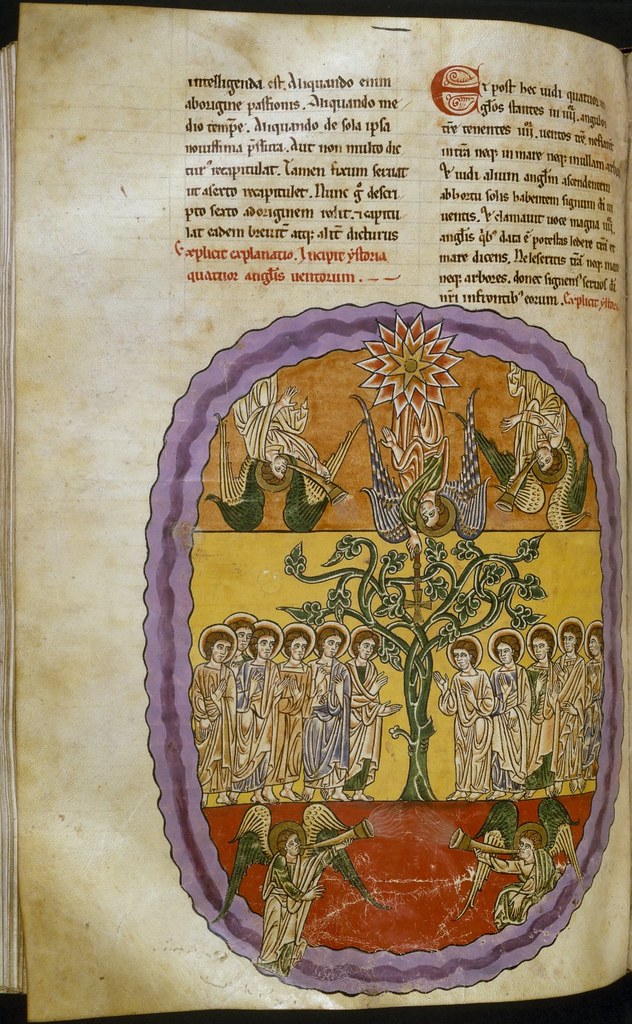
Angels
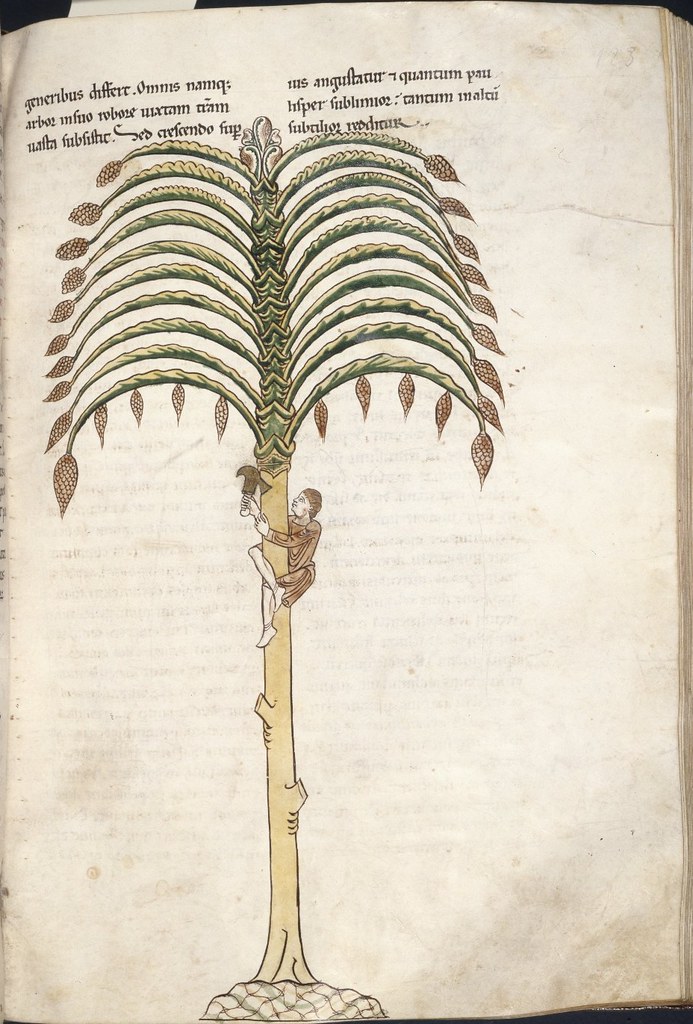
Climbing a palm tree

Hic populus meus et habitauit deus cum eis
Christ Enthroned Over the River of Life
Christ Enthroned Over the River of Life
"He took me up a high mountain and showed me the river of the water of life, shining like crystal, proceeding from the throne of God and of the Lamb. In the midst of its main street, and on both sides of the river, was the Tree of Life, bearing twelve fruits, offering one for each month, and the leaves are for the health of the nations. But the throne of God and the Lamb will be in it, and his servants shall serve him. They shall see his face and his name shall be on their foreheads. Night shall be no more, and they will need neither lamp nor sun because the Lord God will illuminate them. And they shall reign forever and ever." [Revelations 22:1–5]
The enthroned figures holding books and acclaiming God are not mentioned in the text, but the inscription identifies them as "the people of God with whom he lives who will reign forever and ever."
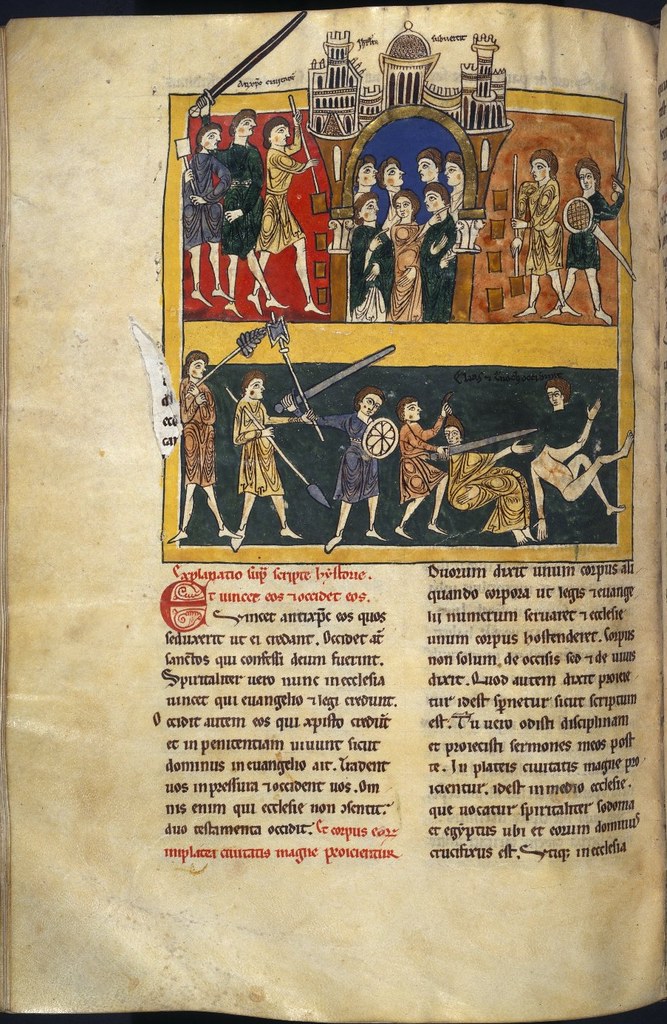
Jerusalem
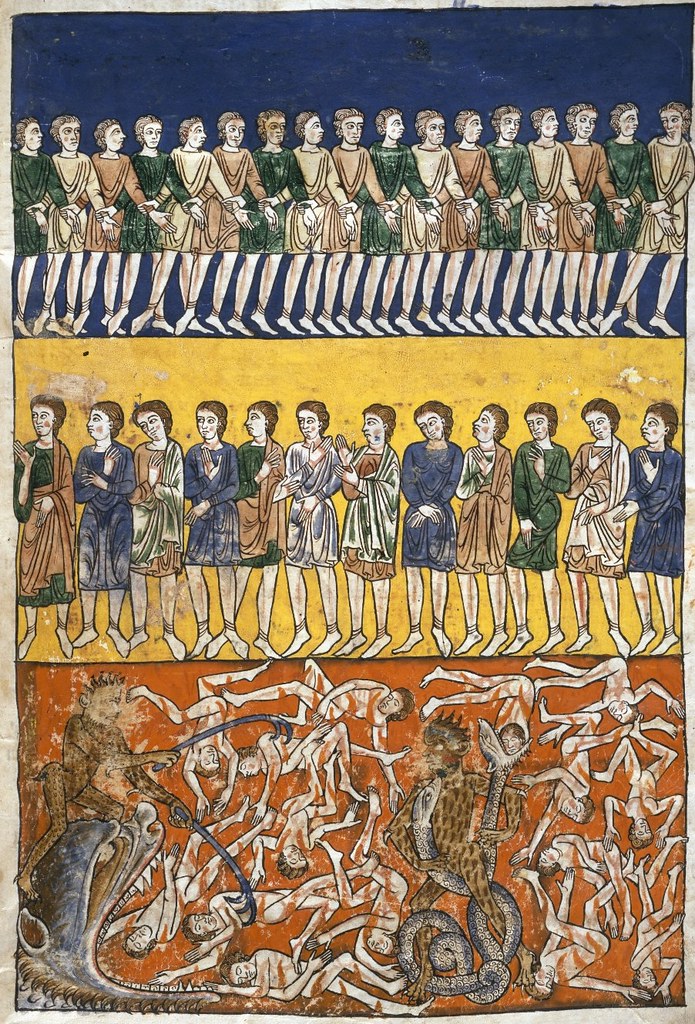
Hell mouth
The commentary on the Apocalypse (Commentaria In Apocalypsin) was written in Spain by Beatus of Liébana in the 8th century.
There are about thirty extant copies of the commentary in illuminated manuscript format, the earliest being from the 9th century. One of the later versions is the Rylands Beatus from the 12th century, owned by the John Rylands Library at the University of Manchester : from which the above images were sourced.
The image notes above are adapted or quoted from captions that appear with equivalent illustrations found in the Morgan Museum's 'Apocalypse Then' exhibition site from a couple of years ago [thumbnail page].
The Morgan appears to own two Beatus manuscripts: MS 644 - the Morgan Beatus - from the 10th century, accessible via the Corsair-Morgan site [MS pdf page descriptions] AND MS 429 - The Las Huelgas Apocalypse - from the 13th century that dominates the exhibition site linked in the paragraph above.
- Wikimedia Apocalypse related images.
- Previously: Apokalypse (and in general: religion & illuminated).
- Wikipedia: Old Maps of the World category page.
- See the Flickr sets: Apocalypse Hell One, Two & Three from Tony Harrison.




No comments:
Post a Comment